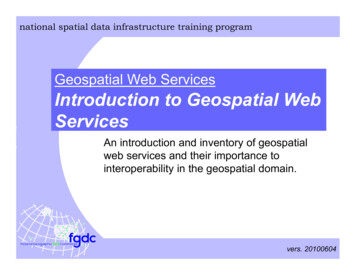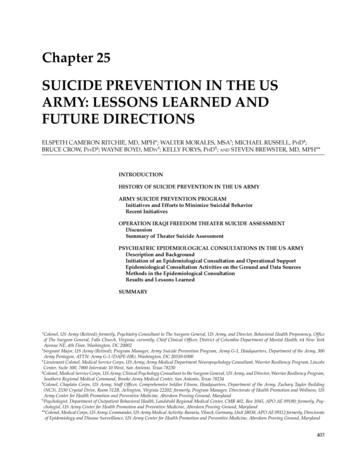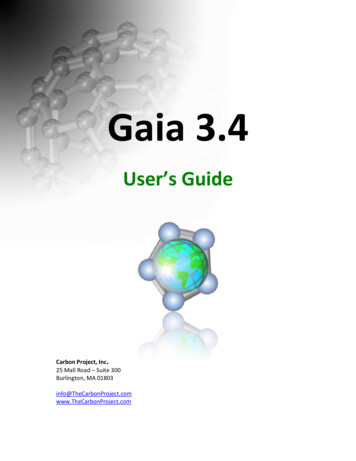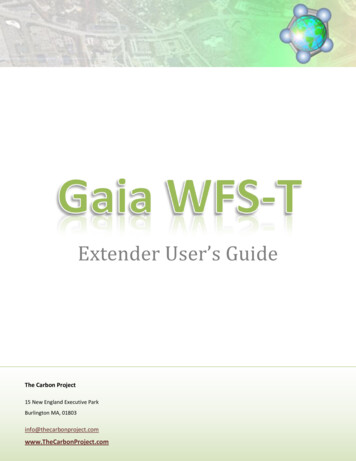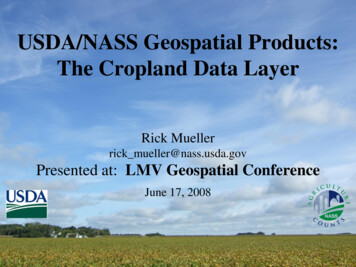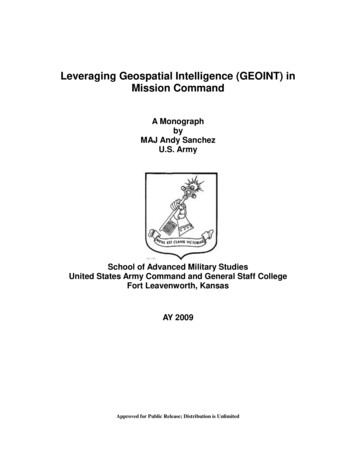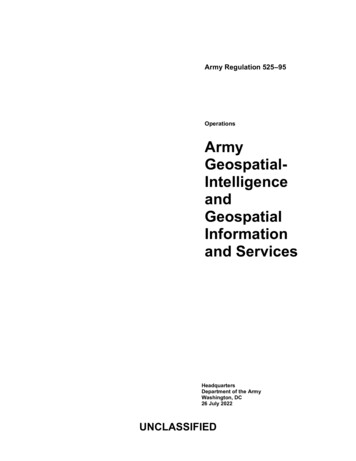
Transcription
Army Regulation spatialInformationand ServicesHeadquartersDepartment of the ArmyWashington, DC26 July 2022UNCLASSIFIED
SUMMARYAR 525–95Army Geospatial-Intelligence and Geospatial Information and ServicesThis new Department of the Army regulation, dated 26 July 2022—oChanges the publication’s series and title from AR 115–11 to AR 525–95 to address operational issues identifiedwithin U.S. Army Training and Doctrine Command Geospatial-Intelligence Doctrine, Organization, Training,Materiel, Leadership and Education, Personnel, Facilities and Policy assessment.oUpdates and adds responsibilities for conducting Army Geospatial-Intelligence and Geospatial Information andServices operations and activities in a unified and synchronized manner (chap 1).oRevises policies for the governance framework and interoperability mandates (chap 2).oRevises the policies for requesting Geospatial-Intelligence and Geospatial Information and Services collection,analysis, production, data, support, and services (chap 3).oRevises the policies for ordering products from the Defense Logistics Agency (chap 3).oRevises the policies for identifying, validating, and prioritizing Geospatial Information and Services requirementsfor training, mission rehearsal, exercises, and systems in accordance with Chairman of the Joint Chiefs of StaffInstruction 3901.01F to National Geospatial-Intelligence Agency (chap 3).oRevises the policies for information assurance and safeguarding Geospatial-Intelligence and GeospatialInformation and Services (chap 3).oIncorporates polices for National Geospatial-Intelligence Agency Targeting Coordinate MensurationCertification and Program Accreditation pursuant to Chairman of the Joint Chiefs of Staff Instruction 3505.01D(chap 4).oIncorporates the policies for Army personnel to participate in the DoD Geospatial-Intelligence CertificationProgram in accordance with DoDI 3115.11 and DoDM 3305.10 (chap 4).oIncorporates the policies for Army personnel to participate in academic programs offered by the NationalGeospatial-Intelligence College (chap 4).oIncorporates the policies for Army personnel to apply for Defence School of Geospatial Intelligence (chap 4).oIncorporates policies for Geospatial-Intelligence (throughout).
Army Regulation 525–95HeadquartersDepartment of the ArmyWashington, DC26 July 2022Effective 26 August 2022OperationsArmy Geospatial-Intelligence and Geospatial Information and ServicesGuard/Army National Guard of the Chief of Staff, G–2 (DAMI– OI), 1040United States, and the U.S. Army Re- Army Pentagon, Washington, DC201310–1040.serve, unless otherwise stated.History. This is a new Department ofthe Army regulation.Summary. This regulation establishesthe frameworks, policies, roles, and responsibilities for conducting Army Geospatial-Intelligence and Geospatial Information and Services operations and activities in a unified and synchronized manneracross all warfighting functions and enabling generating force activities and functions that support military operations suchas Installation and Environmental Management, Civil Works and Civil Emergency Management, and Modeling andSimulations. It revises organizationalstructures, responsibilities, and capabilities, to include requesting National Geospatial-Intelligence Agency products.Applicability. This regulation appliesto the Regular Army, the Army NationalProponent and exception authority.The proponent of this regulation is theDeputy Chief of Staff, G–2. The proponent has the authority to approve exceptions or waivers to this regulation that areconsistent with controlling law and regulations. The proponent may delegate thisapproval authority, in writing, to a division chief within the proponent agency orits direct reporting unit or field-operatingagency, in the grade of colonel or the civilian equivalent. Activities may request awaiver to this regulation by providing justification that includes a full analysis ofthe expected benefits and must includeformal review by the activity’s senior legal officer. All waiver requests will be endorsed by the commander or senior leaderof the requesting activity and forwardedthrough their higher headquarters to thepolicy proponent. Refer to AR 25–30 forspecific requirements.Suggested improvements. Usersare invited to send comments and suggested improvements on DA Form 2028(Recommended Changes to Publicationsand Blank Forms) directly to the DeputyChief of Staff, G–2 (DAMI– OI), 1040Army Pentagon, Washington, DC20310–1040.Committee management. AR 15–39requires the proponent to justify establishing/continuing committee(s), coordinatedraft publications, and coordinate changesin committee status with the Office of theAdministrative Assistant to the Secretaryof the Army, Department of the ArmyCommitteeManagementOffice(AARP–ZA), 9301 Chapek Road, Building 1458, Fort Belvoir, VA 22060–5527.Further, if it is determined that an established “group” identified within this regulation later takes on the characteristics ofa committee, as found in AR 15–39, thenArmy internal control process. the proponent will follow all AR 15–39This regulation contains internal control requirements for establishing and continprovisions in accordance with AR 11–2 uing the group as a committee.and identifies key internal controls thatDistribution. This publication is availmust be evaluated (see appendix C).able in electronic media only and is inSupplementation. Supplementationtended for the Regular Army, the Armyof this regulation and establishment of National Guard/Army National Guard ofcommand and local forms are prohibited the United States, and the U.S. Army Rewithout prior approval from the Deputy serve.Contents (Listed by paragraph and page number)Chapter 1Introduction, page 1Section IGeneral, page 1Purpose 1–1, page 1References and forms 1–2, page 1Explanation of abbreviations and terms 1–3, page 1Responsibilities 1–4, page 1Records management (recordkeeping) requirements 1–5, page 1*This regulation supersedes AR 115-11, dated 28 August 2014.AR 525–95 26 July 2022UNCLASSIFIEDi
Contents—ContinuedSection IIResponsibilities, page 1Assistant Secretary of the Army (Acquisition, Logistics and Technology) 1–6, page 1Chief Information Officer 1–7, page 2Deputy Chief of Staff, G–2 1–8, page 2Deputy Chief of Staff, G–3/5/7 1–9, page 3Deputy Chief of Staff, G–4 1–10, page 4Deputy Chief of Staff, G–6 1–11, page 4Deputy Chief of Staff, G–8 1–12, page 4Deputy Chief of Staff, G–9 1–13, page 5Chief, Army Reserve 1–14, page 5Chief of Engineers 1–15, page 5Commanding General, U.S. Army Forces Command 1–16, page 7Commanding General, U.S. Army Training and Doctrine Command 1–17, page 7Commanding General, U.S. Army Materiel Command 1–18, page 7Commanding General, Army Futures Command 1–19, page 8Commanders of Army Service Component Commands 1–20, page 8Chief, National Guard Bureau 1–21, page 9Chapter 2Governance and Interoperability, page 9Section IGovernance, page 9Army Geospatial-Enterprise Governance Board 2–1, page 9Geospatial-Enterprise Governance Board Council of Colonels and Working Groups 2–2, page 10National System for Geospatial-Intelligence Interoperability 2–3, page 10Chapter 3Collection, Analysis, Production, Data, Support, and Services, page 11Section IObtaining or Requesting, page 11Requesting organic support 3–1, page 11Obtaining reach back support 3–2, page 11Access National System for Geospatial-Intelligence libraries and archives 3–3, page 11Tasking national and commercial remote sensing capabilities 3–4, page 11Requesting Airborne intelligence surveillance and reconnaissance 3–5, page 12Ordering Defense Logistics Agency products 3–6, page 12Submitting Geospatial Information and Services requirements to the National Geospatial-IntelligenceAgency 3–7, page 12National Geospatial-Intelligence Agency Enterprise Request Framework Process 3–8, page 13Section IIProducing and Disseminating, page 13Geospatial-Intelligence analytic standards 3–9, page 13Position reference 3–10, page 13Sharing and re-use 3–11, page 13Reproduction, Duplication, and Corrections 3–12, page 13Defense Support to Civil Authorities 3–13, page 14Request for reimbursement 3–14, page 14Augmenting National Geospatial-Intelligence Agency standard production 3–15, page 14Section IIIInformation Assurance and Safeguarding, page 14Information assurance and safeguarding 3–16, page 14Freedom of Information Act 3–17, page 14AR 525–95 26 July 2022ii
Contents—ContinuedDisclosure and release 3–18, page 15Foreign agreements 3–19, page 15Website management 3–20, page 15Chapter 4Interagency Certification and Tradecraft, page 15Target Coordinate Mensuration Certification and Program Accreditation 4–1, page 15Department of Defense Geospatial-Intelligence Professional Certification 4–2, page 15National Geospatial-Intelligence College 4–3, page 16Defence School of Geospatial Intelligence Master’s Program 4–4, page 16AppendixesA. References, page 17B. Geospatial Information and Services Requirements Submission Format, page 22C. Internal Control Evaluation, page 25Figure ListFigure B–1: Example of memorandum for ad hoc GI&S, page 23GlossaryAR 525–95 26 July 2022iii
Chapter 1IntroductionSection IGeneral1–1. PurposeThis regulation prescribes the polices and responsibilities; as well as, establishes the Army governance frameworks toconduct Geospatial-Intelligence (GEOINT) and Geospatial and Information Services (GI&S) operations and activitiesin a unified and synchronized manner across all Warfighting Functions and enabling generating force functions.GEOINT, in the context of this Army Regulation, refers to the activities that are funded by intelligence appropriations,subject to intelligence oversight, and constitute an intelligence activity governed by Executive Order 12333 (asamended). The objective of this regulation is to ensure that GEOINT and GI&S operations and activities are treatedas high-priority efforts and conducted in a unified and synchronized manner due to the vital role they play in thesuccessful conduct of military operations and activities, in executing the mission of the Department of Defense, andin supporting national security. This regulation will ensure GEOINT and GI&S are available for decision makers andcommanders to evaluate numerous options for executing simultaneous and sequential operations using the rapid andcontinuous integration of capabilities, across all domains, to present multiple dilemmas to an adversary in order toachieve surprise, gain physical information advantage, and influence and control the operational environment.1–2. References and formsSee appendix A.1–3. Explanation of abbreviations and termsSee the glossary.1–4. ResponsibilitiesSee section II of chapter 1.1–5. Records management (recordkeeping) requirementsThe records management requirement for all record numbers, as associated forms and reports required by this regulation are addressed in the Records Retention Schedule-Army (RRS –A). Detailed information for all related recordnumbers, forms, and reports are located in Army Records Information Management System (ARIMS)/RRS–A athttps://www.arims.army.mil. If any record numbers, forms, and reports are not current, addressed and/or publishedcorrectly in ARIMS/RRS–A, see DA Pam 25–403 for guidance.Section IIResponsibilities1–6. Assistant Secretary of the Army (Acquisition, Logistics and Technology)The ASA (ALT) will—a. Ensure Army materiel solutions that use or produce GEOINT are in compliance with the GEOINT architectureand standards prescribed by the Director, National Geospatial-Intelligence Agency (NGA) in accordance with Chairman of the Joint Chiefs of Staff Instruction (CJCSI) 3110.08, Department of Defense Directive (DoDD) 5105.60, andDoDI 8330.01.b. Ensure Army materiel solutions are designed to make maximum use of the GEOINT provided by NGA andcoordinate unique materiel system requirements with Deputy Chief of Staff (DCS), G–2, Chief of Engineers (COE),and the Army Geospatial Information Officer (GIO) for coordination with NGA pursuant to CJCSI 3110.08 and DoDI5000.56.c. Consult with the Army GIO on implementation profiles of geospatial information standards to inform policy,directives, and guidance to the Army Acquisition Community to ensure interoperability among Army materiel solutions.AR 525–95 26 July 20221
d. Support the DCS, G–2, COE, and Army GIO with reviewing NGA intelligence mission data plans per DoDD5250.01 to ensure NGA data architecture, formats, compatibility and standards, and dissemination methods satisfyArmy acquisition program requirements.e. Support the DCS, G–2 by designating a representative to serve within the Service GEOINT Element (SGE) tocoordinate Army Tactical Exploitation of National Capabilities (TENCAP) Program related matters with NGA inaccordance with DoDD 5105.60 to ensure NGA efforts meet current operational requirements where applicable andfacilitate exploration of new concepts for using national intelligence systems to support operations at the tactical level.f. Designate a representative to serve as a member of the Army 3-Star Geospatial-Enterprise Governance Board(GGB) and designate representatives to support the 1 and 2-Star GGB, the GGB Council of Colonels (CoC) andGeospatial Standing Task Force (GSTF).1–7. Chief Information OfficerThe CIO will—a. Support the DCS, G–2 by providing guidance regarding GEOINT information sharing management to promoteinteroperability, reuse, portability, and cybersecurity within the DoD, as well as with federal agencies and multinational partners pursuant to DoDI 8130.01.b. Serve as a member of the Army 3-Star GGB and designate representatives to support the 1 and 2-Star GGB, theGGB CoC and GSTF.1–8. Deputy Chief of Staff, G –2The DCS, G–2 will—a. Provide advice and plan, supervise execution, and report the performance and progress of policies and programsfor all GEOINT-related activities and functions for the Department of the Army.b. Ensure the Army GEOINT enterprise leverages national capabilities and is able to share GEOINT by the mostefficient and expeditious means consistent with DoDI 8320.02, Under Secretary of Defense (USD) for Intelligenceand Security (USD (I&S)), and Director of National Intelligence (DNI) security and information sharing policies.c. Lead the Army SGE with representation from various Army organizations. The Army GEOINT Office (AGO)is the G – 2 office within NGA facilities that serves as the Army's conduit into the NGA and the National/AlliedSystem for Geospatial-Intelligence (NSG/ASG) representing the spectrum of the Army's interests and equities in theGEOINT arena on behalf of stakeholders.d. Coordinate changes to Army GEOINT concepts of operations, force structure, and systems across the DoD andIC.e. Formulate requests and manage GEOINT resources for the Army Military Intelligence Program (MIP) and National Intelligence Program (NIP). This includes—(1) Planning and programming for GEOINT resources in accordance with the MIP fiscal policy and the guidanceestablished by the USD (I&S) in accordance with DoDD 5205.12 and the National System for GEOINT (NSG) programming and budgeting guidance from the Director, NGA in accordance with DoDI 3115.15.(2) Coordinating and synchronizing GEOINT plans, programs, and budgets with the Director, NGA, as appropriatepursuant to DoDI 3115.15.(3) Informing the Intelligence Community (IC) GEOINT Functional Manager’s state-of-the-function report toUSD (I&S) and DNI pursuant to DoDD 5105.60 and Intelligence Community Directive (ICD) 113.(4) Provide functional management oversight to the Army National-to-Theater (NTT) program.(5) Publish an annual NTT report in accordance with NSG Directive 3104.(6) Responding to the Army, NGA, USD (I&S), ODNI, or congressional inquiries related to all GEOINT expenditures.f. In coordination with DCS, G–8 and OCE, review GEOINT Joint Requirement Oversight Council (JROC) andIC Capability Review Council requirement documentation to ensure DoD and IC GEOINT capabilities support Armyrequirements.g. Provide support to the DoD GEOINT Manager and IC GEOINT Functional Manager by providing representation to the NSG Senior Management Council (NSMC) and designating Army personnel to support the GEOINT Committee (GEOCOM) governance structure in accordance with DoDD 5105.60 and ICD 113.h. Support the Joint Staff with conducting biennial Combat Support Agency Review Team assessments of NGAin accordance with Section 193, Title 10, United States Code (10 USC 193) and CJCSI 3460.01.i. Support NGA’s annual review and validation of the size, composition, responsibilities, and location of NGApersonnel embedded within the Army to ensure optimal alignment of support to the Army’s needs and to informService resource and strategic decisions in accordance with DoDD 3000.06.AR 525–95 26 July 20222
j. Serve as the Army voting representative to the NSG GEOINT Standards Working Group (GWG) to establishand maintain the GEOINT standards baseline for the DoD and IC.k. Validate all GEOINT related support agreements pursuant to DoDI 4000.19 between the Army and DoD or ICorganizations.l. Appoint representatives to validate Army submissions into the NGA enterprise framework process.m. Designate member(s) of the Office of the Deputy Chief of Staff (ODCS), G–2 to serve as the Army GI&SOfficer in accordance with CJCSI 3901.01F responsible for:(1) Coordinate with each Combatant Command (CCMD) and Army Service Component Command (ASCC) designated GI&S Officer to submit geographic GI&S statement of requirements (SOR) for training, exercises, materialsystem development, and deployment readiness to NGA.(2) Develop an Armywide GI&S requirement production list based off NGA’s capacity and capability then submitto commanders of Army organizations and units for execution.n. Lead the SGE in accordance with DoDD 5105.60. This includes designated members of the ODCS, G–2 to servewithin the SGE and embedding Army personnel into NGA, as appropriate.o. Coordinate with Joint Task Forces (JTFs), CCMDs, and national-level agencies and organizations to ensure thatGEOINT actions, issues, and initiatives are staffed across the Army.p. Implement the DoD GEOINT professional certification program in accordance with DoDI 3115.11 and DoDM3305.10 to ensure GEOINT personnel are trained to IC analytic standards, as appropriate. This includes:(1) Designating a representative to serve on the NGA GEOINT Professional Certification Council.(2) Reporting status of implementation to the DoD GEOINT Manager and USD (I&S).(3) Validating DoD GEOINT certification candidate lists submitted to the Army from the NGA certification program management office for recommendation before submission to the USD (I&S) for conferral of certifications.(4) Appointing an Army representative to the Community GEOINT Training Council (CGTC) in accordance withDoDI 3305.10.q. Co–chair, with the COE, the Army 3-Star GGB and designate representatives to support the 1 and 2-Star GGB,GGB CoC, and GSTF.r. Serve as a NSG member.s. Ensure the Commanding General, U.S. Army Intelligence and Security Command (INSCOM) will—(1) Designate representative(s) to serve within the Army SGE to coordinate INSCOM-related GEOINT matterswith NGA and NSG members in accordance with DoDD 5105.60.(2) Oversee execution of the Army NTT program in accordance with the guidance and direction provided by theDCS, G–2 and the IC GEOINT Functional Manager in accordance with NSG instructions and directives, as appropriate.(3) Ensure Army GEOINT analysts, military and civilians, assigned to INSCOM units and organizations are certified in accordance with the DoD GEOINT Certification program, as appropriate.(4) Support DCS, G–2 with reviewing NGA GEOINT products and services to include sunset positions and/orchange recommendations.(5) Support DCS, G–2 with reviewing GEOINT standards recommended for inclusion in, or retirement from, theDoD Information Technology Standards Registry (DISR) through the GWG.(6) Coordinate and synchronize GI&S requirements necessary to support Hard Targets, Defense Intelligence Analysis Program (DIAP) responsibilities, and other INSCOM missions with the COE and the Army GIO, as appropriate.(7) Serve as a NSG member.(8) Collaborate with the Commanding General (CG), U.S. Army Corps of Engineers (USACE) to ensure synchronization between GI&S and GEOINT-related initiatives.(9) Designate representatives to support the 1 and 2-Star GGB, the GGB CoC, and GSTF.(10) Execute GEOINT Foundry training in accordance with AR 10–87, AR 350–32 and DCS, G–2 guidance.(11) Designate a Departmental Requirements Officer (DRO), with direct liaison authority to DCS, G–2, to serveas the final departmental validating authority for all Army national imagery collection requests and produce and maintain Proper Use Memorandums (PUMs).1–9. Deputy Chief of Staff, G –3/5/7The DCS, G–3/5/7 will—a. Resource GEOINT and Geospatial Engineer troop organization, force structure, operations, training, and readiness.AR 525–95 26 July 20223
b. Prioritize all materiel programs supporting the standards and architecture prescribed by the Director, NGA asthe DoD Lead for GEOINT standards, in coordination with ASA (ALT) and the DCS, G–8 in accordance with DoDI5000.56, DoDD 5250.01, and DoDI 8330.01.c. Ensure that the Commander, U.S. Army Aeronautical Services Agency coordinates Army aviation, air trafficcontrol, Army airfields or heliports, and Airspace Operations imagery and GI&S requirements with the DCS, G–2,COE, Army GIO, CG, U.S. Army Training and Doctrine Command (TRADOC), and CG, Army Futures Command(AFC) to eliminate duplication, avoid redundant expenditures, and maximize sharing of resources.d. Support the DCS, G–2, COE, and Army GIO by assessing NGA’s Foundation GEOINT Intelligence MissionData (IMD) and prioritizing Army GI&S requirements.e. In accordance with AR 115–13, ensure the Sustainable Range Program (SRP) GI&S program lead coordinatesand reconciles SRP, Installation GI&S (IGI&S), and military installation maps production plans and requirementswith DCS, G–2, COE, Army GIO, CG, TRADOC, CG, AFC, and DCS, G–9 to eliminate duplication, avoid redundantexpenditures, and maximize sharing of resources.f. Provide Army aviation representation supporting the GEOCOM governance structure, specific to activities involving Aeronautical safety of navigation, in accordance with DoDD 5105.60 and CJCSI 3901.01F.g. Serve as a member of the Army 3-Star GGB and designate representatives to support the 1 and 2-Star GGB, theGGB CoC and GSTF.h. Serve as a NSG Partner.1–10. Deputy Chief of Staff, G– 4The DCS, G–4 will—a. Serve as the Army Staff central point of contact for supply and storage of GI&S material.b. Assist the Army Staff, in collaboration with the CG, Combined Arms Support Command (CASCOM) and theCG, U.S. Army Materiel Command (AMC), to identify, track and monitor logistics concepts, policy, funding anddistribution funding for the Logistics Business and Warfighting Domain requirements that may have GEOINT andGI&S application.c. Maintain liaison with the Director, Defense Logistics Agency (DLA), the Director, U.S. Transportation Command (TRANSCOM), Surface Deployment and Distribution Command (SDDC), and other DoD agency leaders onGEOINT and GI&S-related logistics concepts, policy, requirements, funding, life cycle planning and applications.This includes supply distribution guidance for standard GI&S products as appropriate.d. Maintain liaison with CG, CASCOM and Director, DLA to ensure that GI&S are integrated into the Armysupply system, Army supply officer, and/or supply point of contact processes and procedures and in accordance withDLA mapping and customer guidance.e. Pursuant to CJCSI 3110.08, CJCSI 3901.01F and AR 56–9, coordinate GI&S requirements for logistics andwatercraft missions with the DCS, G–2, COE, Army GIO, CG, TRADOC, CG, AFC, and DCS, G–9 to eliminateduplication, avoid redundant expenditures, and maximize sharing of resources.f. Review NGA and Army GI&S production priorities and plans for impact on DCS, G–4 functional areas andwatercraft capabilities.g. Provide Army watercraft representation supporting the GEOCOM governance structure, specific to activitiesinvolving Maritime safety of navigation, in accordance with DoDD 5105.60 and CJCSI 3901.01F.h. Serve as a member of the Army 3-Star GGB and designate representatives to support the 1 and 2-Star GGB, theGGB CoC and GSTF.i. Serve as a NSG Partner.1–11. Deputy Chief of Staff, G– 6The DCS, G–6 will—a. Consider Army GIO certification program findings and results during Army Interoperability Certification (AIC)adjudication and determination.b. Serve as a member of the Army 3-Star GGB and designate representatives to support the 1 and 2-Star GGB, theGGB CoC and GSTF.1–12. Deputy Chief of Staff, G– 8The DCS, G–8 will—a. Develop, independently assess, integrate, and synchronize materiel solutions to achieve interoperability throughthe architecture and standards prescribed by the Director of NGA and the Army GIO in accordance with DoDD5105.60 and DoDI 8330.01.AR 525–95 26 July 20224
b. Ensure Army systems producing or consuming GEOINT and/or GI&S are appropriately resourced to ensure thesuccessful integration of the interoperability amongst DoD systems and networks.c. Ensure the Director, Center for Army Modeling and Simulation Office (AMSO) will(1) Serve as the Army Senior Modeling & Simulations Advocate.(2) Coordinate issues with the DCS, G–2; GIO; and DCS, G–3/5/7 to ensure interoperability and sharing and/orreuse between the operational and generating force.d. Coordinate the Army modeling and simulation prescribed standards, architectures, and data models with theArmy GIO to ensure training and operational system geospatial interoperability with stakeholders such as Chief,AMSO, CG, AFC, and Program Executive Officer for Simulation, Training and Instrumentation.e. Serve as a member of the Army 3-Star GGB and designate representatives to support the 1 and 2-Star GGB, theGGB CoC and GSTF.f. Serve as a NSG Partner.1–13. Deputy Chief of Staff, G– 9The DCS, G–9 will—a. Advise the Assistant Secretary of the Army (Installation, Energy and Environment (ASA (IE&E)) on the development and implementation of Installation GI&S (IGI&S) policies, programs, production, and requirements in accordance with AR 115–13.b. Assist the ASA (IE&E) on coordinating Army IGI&S program policy, documentation, acquisition plans, andimagery requirements with the DCS, G–2, COE, and Army GIO to eliminate duplication, avoid redundant expenditures, and maximize sharing of resources.c. Support the DoD GEOINT Manager with facilitating use and discovery of IGI&S across the NSG, and facilitateefforts to make IGI&S data and metadata visible and accessible (to the maximum extent allowed by law or DoDpolicy) across the federal data sharing environment, to include the Geospatial Platform per DoDI 8130.01.d. Serve as a member of the GSTF.e. Serve as a NSG partner.1–14. Chief of Army ReserveThe CAR, through the Office of the Chief of Army Reserve (OCAR) G–2, will—a. Designate an OCAR central point of contact for GEOINT to coordinate all GEOINT issues with the DCS, G–2for further coordination with the Director, NGA, the other Services’ GI&S proponents, the Joint Staff, and the IC.b. Develop OCAR GEOINT-related policies consistent with this regulation.c. Coordinate GI&S requirements for training, mission rehearsal, exercises, and systems to effectively train, man,and equip OCAR personnel with DCS, G–2, COE, Army GIO, CG, TRADOC, and CG, AFC to eliminate duplication,avoid redundant expenditures, and maximize sharing of resources in accordance with CJCSI 3901.01F.d. Support DCS, G–2, COE, and Army GIO by reviewing NGA and Army GEOINT and GI&S plans and strategies.e. Support DCS, G–2 by reviewing GEOINT standards to ensure proposed standards recommended for inclusionin, or retirement from, the DISR support OCAR functional areas.f. Serve as a member of the Army 3-Star GGB and designate representatives to support the 1 and 2-Star GGB, theGGB CoC and GSTF.g. Serve as a NSG partner.1–15. Chief of EngineersThe COE will—a. Serve as the designated Joint Capability Area Manager for Operational Engineering in accordance with DoDD7045.20.b. Provide representation to the NSMC and designate Army personnel to support the GEOCOM governance structure.c. Serve as the Headquarters, Department of the Army (HQDA) office of primary responsibility for coordinationbetween the Army and the NSG regarding matters related to the Defence School of Geospatial Intelligence (DSGI),and designate a representative to serve as the Army voting member on the NSG-led DSGI Selection Panel.d. Co-chair, with the DCS, G–2, the Army 3-Star GGB and designate representatives to support the 1- and 2-StarGGB, the GGB CoC, and GSTF.e. Designate a management decision package (MDEP) manager to serve as the focal point for functional and programmatic integration of Army Geospatial Support (MDEP EMAP) and to link program policy with resources for theprogram evaluation group in accordance with AR 1–1.AR 525–95 26 July 20225
f. Serve as the Topographer of the Army and HQDA office of primary responsibility for Geospatial Engineeringand responsible for providing GI&S expertise and support to the U.S. Army Engineer School (USAES) and USACE.g. Appoint representatives to validate Army submissions into the NGA enterprise framework process.h. As Chief of Branch, the COE is responsible for leading the Corps of Engineers (Engineer Regiment) to ensuregeneration and management of geospatial engineers and the training, education, certification, management, and integration of geospatial engineering within the Army, in accordance with 10 USC.i. Provide support to the DCS, G–2 to:(1) Coordinate Geospatial Engineering
o Incorporates polices for National Geospatial -Intelligence Agency Targeting Coordinate Mensuration Certification and Program Accreditation pursuant to Chairman of the Joint Chiefs of Staff Instruction 3505.01D (chap 4). o Incorporates the policies for Army personnel to participate in the DoD Geospatial-Intelligence Certification
